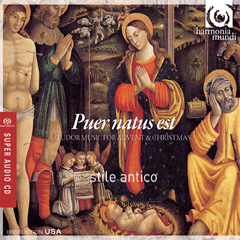Classical Music Review: Stile Antico Enchants Singing Tudor Music for Christmas and Advent
Most importantly, there were the amazing, booming acoustics of St. Paul’s, which favored the soaring soprano voices that were, for me, the reason to see this excellent ensemble.
By Susan Miron
For the second year in a row, St. Paul’s Church in Cambridge, MA, hosted a concert by the superstar, Early Music group, Stile Antico on Saturday, December 17.
Stile Antico, a group of 13 British singers who befriended each other a few years ago while at Oxford and Cambridge Universities, almost fell into fame (as one of its singers pointed out in an informal pre-concert talk) when, at a choral competition, the head of the record label Harmonia Mundi, who was there, loved them. They have been with Harmonia Mundi ever since; their are CDs best sellers, and they give 45 concerts a year.
A hysterically enthused New York Times reporter recommended them this past Sunday (December 18): “A superlative young English choral ensemble” whose CD, upon which this program in Boston was based was “deliriously lovely . . . Listening will restore meaning to the holidays despite the retail onslaught.” No critic seems immune to superlatives when describing this group.
Well, I didn’t need my holiday’s meaning restored, and I am not tempted to participate in retail madness. I bought their CD but didn’t care for it nearly as much as their concert. Two things made a huge difference. On the recording, Tallis’s music was placed first, followed by William Byrd’s four pieces. In the concert, they were mixed up, woven together, forming a deft arrangement of this music and its liturgical moods.
Most importantly, there were the amazing, booming acoustics of St. Paul’s, which favored the soaring soprano voices that were, for me, the reason to see this excellent ensemble. The sopranos were simply amazing, hitting high notes with perfection and with what seemed like effortless ease. Intonation throughout the concert was dead perfect, no small feat. And the singers are attuned to getting across the meaning of the texts.
Word about this youthful group of singers (almost no one wore glasses, all but perhaps one had his or her original hair color) has gotten out in Boston. St. Paul’s was packed. As our pre-concert lecturer pointed out, Stile Antico is a conductor-less ensemble, which isn’t as challenging for this group as it might be for a modern instrumental or vocal ensemble because Renaissance music has a regular pulse. Thus, “on a good day, we don’t need someone beating time. While they have always rehearsed as equals, a committee of four or five chooses a theme or event on which to develop a program. The music the group performs is at the core of the English choral tradition, and most of these singers have been performing it since they were very young.
The heart of this program was Tallis’s incomplete, seven-voice Christmas Mass, Missa Puer natus est (A boy is born), based on the plainchant Puer natus est nobis—the introit for Christmas Day mass. A model of intricate compositional virtuosity, the plainchant goes through an elaborate treatment of innovative, contrapuntal techniques. What matters to those reading this is that it was sung simply beautifully, with emotional immediacy. You could easily enjoy this music, and the rest of the program without understanding the first thing about Renaissance polyphony. Hearing it done by Stile Antico is its own reward. (Much of this program is on YouTube, all of it is on their recent CD Puer natus est)
The flexibility of having no conductor for the six women and seven men enables the group to morph into various sizes ensembles, including the seven-voice ensemble in the Tallis. Generally they sing in place, in a semi-circle, affording them good eye contact. The second group of pieces interspersed between the Tallis movements (“Videte miraculum,” “Gloria,” “Sanctus and Benedictus,” “Agnus Dei”) were four Propers for the fourth Sunday of Advent, seasonal liturgical texts by William Byrd (ca. 154–1623). Byrd composed a generation after Tallis; his music makes for smoother listening, lacking, alas, Tallis’s wonderfully crazy harmonies, cross relations that sound tangy and bizarre.
Other music from the English Tudor period included Johns Sheppard’s (ca. 1515–1558) beautiful Verbum caro performed after the haunting Plainchant Puer natus est, John Taverner’s (ca.1490–1545) Audivivi vocem de caelo written for upper voices, and Robert White’s (ca. 1538–1574) fascinating setting of the Magnificat, full of surprises in the vocal writing.
After the obligatory standing ovation (I cannot go to a concert without having this occur), there was lovely encore by this year’s ubiquitous composer, Tomás de Victoria, who died 400 years ago. It was a nice touch to include him as the year winds down. Like everything else on the program, it was sung with great beauty and serenity.
Tagged: Christmas Mass, Early Music, Harmonia Mundi, Missa Puer natus est, St Paul's Church


